Pros
Cons
Tour & Design
One of the most striking features about the Beats is their glossy black outer shell.
The left, center, and right views of the Beats.
and turns
yellow when batteries are low. Hit the 'b' above
the switch to mute playback.
The inside of the band is metal and non-glossy black plastic. At the top of the band's inside is a small pad covered in a soft, faux-leather material. Part way down the band are some hinges, which allow the cups to flip up and nestle against the band.
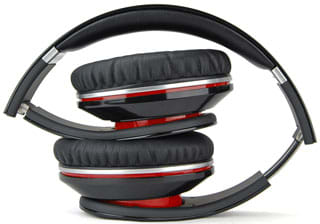
The Beats can fold up to aid portability.
The ear cups are glossy black plastic with red detailing and a metal ring between the bulk of the cup and the padding. The back of each ear cup has a silver disk with a red 'b' in it as well as a unique feature. The 'b' panel on the left cup can twist off, revealing the battery cavity. The right 'b' panel will mute playback when pressed. The right ear cup also has an on/off switch: when it's turned on, an LED in the center will glow red. The cup padding again uses the faux-leather material and has a cloth to block the inside from invading dust and grossness.
In the Beats' elaborate box, you'll find two sets of cables, one of which has a headset microphone on it, a 1/4-inch adapter, an airplane adapter, a case, and a red cloth, which you can use to control the fingerprint population on the Beats' glossy black plastic.
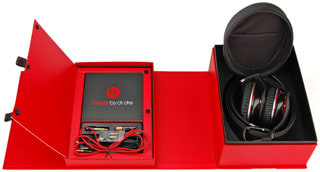
**The Beats come with two adapters, two cables, a cleaning cloth, **
and packaging that's far more classy than it needs to be.
The Beats had a few durability issues. First of all, the plastic used seems cheap; when you twist it around it creaks, and it we weren't able to bend it very far without getting the sensation they were going to break. The ear cups were particularly troubling, since they were so loosely attached to the band. The other area of concern was in regards to the cables: we can see many a cable breaking at the point where the cord meets the plug. The reason for this is a total lack of cord guard. A cord guard prevents the wire from bending in on itself too much. At the plug, the wire can bend very sharply, conforming to the plug's edge. This means the wire is more susceptible to shearing, since the wire will be bending and rubbing up against sharp-ish 90-degree angle. Also, we noticed the cord's case came untucked from the plug more easily than we would've expected.
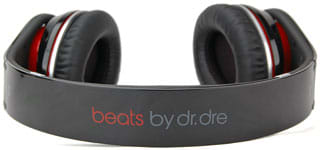
The Beats have a unique aesthetic, which means many people will have a strong love/hate reaction towards it. We noticed that, initially, people tended to think they looked cool -- the 'b' branding was a particular favorite. A few viewers noted that, once they'd handled the Beats for a while, heard the plastic click against itself, and thoroughly greased the outside with fingerprints, they thought much less of them. Some said the Beats looked a bit chinsy, or like a prop from an 80s movie. The general consensus around the office placed these headphones towards the good-looking side of the spectrum. We wouldn't necessarily recommend wearing the Beats at your desk job, but that's partially because we don't think Dr. Dre would necessarily want you wearing the Beats at your desk job.
In summary, the Beats look nice (providing you keep them clean), but aren't necessarily professional.
Performance
About our testing:
Our testing rig is comprised of the same hardware and software manufacturers use to tweak their headphones. The hardware is HATS (head and torso simulator). HATS is shaped like the top half of a person, sans arms, and has powerful microphones in its ears. The software is SoundCheck, which we use to analyze the data captured with HATS. For more information on our tests, read this article.
**Frequency Response** *(5.69)* [

](https://www.reviewed.com/headphones/content/How-We-Test-149.htm#Frequency_Response)
How the test works:
We arrive at our frequency response score by measuring how much emphasis the headphones put on each frequency. First we put the headphones on HATS. Next, we play back a frequency sweep, which runs through all the frequencies between 100 Hz and 20 kHz. Each frequency is fed into the headphones with the same power level, which means, ideally, the headphones would output each frequency at the same decibel level. HATS listens to what's actually coming out of the headphones and reports back to SoundCheck. The graph below shows how the headphones changed the original frequency sweep by adding or subtracting emphasis. The green line represents the left channel (ear cup) and the red is the right. The dotted black lines are the limits both lines should fall between. The bottom of the graph represents the frequencies we played through the headphones, and the left size of the graph represents the decibel level HATS measured.
What we found:
As we speculated in our first look article, the Beats have a relatively flat bass response that's bumping against the top limit. This means an even-sounding bass that's slightly emphasized. You can also see there was an odd plummet towards the high end, wehre the right channel dips below the bottom limit. Towards the high end, it looks like the Beats pick and choose different frequencies to emphasize, leading to an up-and-down scrawl that eventually drops off towards the extreme high end. This series of peaks might make high-pitched sounds seem like they fade in and out slightly, but it's nothing severe enough for most listeners to notice.
Overall, if it weren't for that weird plummit in the high-mids, the Beats would've had a great frequency response. As it stands, they're still above average.
How the Monster Beats compares:
Compared to most other active noise-cancellers we've reviewed, the Beats have one of the more stable frequency responses we've seen. They give a good boost to bass, but that seems to be a trend: the NC500Ds, QuietComfort 3s, and even the Aurvana X-Fi headphones (once you turn the volume up to compensate for their weak response curve) all add a steady emphasis to the bass. The Beats probably wouldn't be great for purists who want their music to come out of the headphones untampered, but their response curve is, for the most part, good.

](https://www.reviewed.com/headphones/content/How-We-Test-149.htm#Frequency_Response)
How the test works:
To get our distortion score, we play a known sound file through the headphones which contains frequencies between 100 Hz and 10 kHz. We have HATS listen to the sound that comes out of the headphoens, and then compare the original sound file to what HATS picked up. Distortion refers to any difference between the original sound file and what ends up going into your ears. On the graph below, the green and red lines again represent the left and right channels respectively; the bottom line also denotes the various frequencies we tested. The left size of the graph represents the percentage of distortion present at any given frequency.
What we found:
When we initially listened to the Beats without music, we noticed the noise cancellation added a noticeable amount of noise. This is probably what that hump around 1 kHz represents. Regardless of the source of the distortion, there's quite a hump present in the mid-range frequencies that gradually trails off towards the high end. Also notice the right channel bump towards the high end: this corresponds to the sudden drop in decibel level present in our frequency response graph above.
How the Monster Beats compares:
Active noise-cancelling headphones typically don't have the lowest distortion. Since active noise cancelling involves injecting your playback with extra soundwaves, their relatively low performance isn't surprising. This being said, the Beats have more of a distortion problem than any of our comparison headphones. These are definitely not headphones for purists.

](https://www.reviewed.com/headphones/content/How-We-Test-149.htm#Tracking)
How the test works:
We test tracking by playing a frequency sweep through the headphones and again assign HATS with the task of listening intently. This time HATS is monitoring the decibel levels of each channel. The data bounces back to SoundCheck, which provides us with our graph. What this graph depicts is which ear cup was louder at each frequency and by how much. For perfect tracking, both channels would be playing at exactly the same levels. On the below graph, when the blue line rises above the zero line, it means the left channel is louder; below the zero line and the right channel is louder. The debcibel levels run down the left side of the graph, which the frequencies we tested span the bottom of the graph.
What we found:
The Beats have tracking problems. Things to look for that are bad include sudden, dramatic shifts in volume. Such shifts are often jarring to the listener. Again, you can see the frequency response graph's results present here: the first big shift towards the left channel corresponds to the sudden drop in the right channel's volume from the frequency response graph.
How the Monster Beats compares:
Well, the Beats didn't have the worst tracking out of all the headphones we've chosen to compare them to, but they came close. The biggest downfall of the Beats is that random drop it has in the right channel. That shift will be more noticeable than any shift on any of the comparison graphs, with the sole exception of the QuietComfort 3s' quick left-right-left change-up around the same frequency.
**Maximum Usable Volume** *(9.07)* [

](https://www.reviewed.com/headphones/content/How-We-Test-149.htm#Maximum_Usable_Volume)
How the test works:
The maximum usable volume test is essentially a series of distortion tests. Each iteration we increase the volume, looking for the point at which distortion levels reach 3%. At this point, the distortion is noticeable and annoying.
What we found:
The Beats were capable of a pretty good audio level: 116.11 decibels. We award maximum points for 120 decibels, but being less than four decibels shy isn't that much of a difference. Those who like their music loud should be just fine with the Beats. Of course, one should take caution with anything over 100 decibels, since it's potentially harmful for your poor little ears. Remember kids, headphones can't make you deaf: they just help careless people make themselves deafer faster.

](https://www.reviewed.com/headphones/content/How-We-Test-149.htm#Isolation)
How the test works:
Isolation refers to the headphones' ability to seal a listener off from the outside world. We test this by placing the headphones on HATS, then bombarding both with pink noise (sounds like the inside of an airplane during a flight). HATS keeps track of the decibel levels of whatever noise makes it through the headphones, and SoundCheck pops out another helpful graph. We perform this test with active cancellation off and on, with the former being green and the latter blue.
What we found:
The Beats don't have the best noise cancellation. Typically the strong suit of active noise cancellation is in the bass frequencies. In this case, however, the active cancellation doesn't do much. It accounts for less than ten extra decibels blocked out in the bass frequencies. Anything higher-pitched than 1 kHz will get blocked out about regardless of whether the active cancellation is on. The active cancellation actually creates noise towards the high end, causing it to perform worse than if you'd just left cancellation off.
How the Monster Beats compares:
The Beats have really poor noise cancellation for a pair of noise-cancellers. The active cancellation accounts for such a tiny bump that it's hard to justify its inclusion -- especially since the mandatory battery life so limits the Beats' functionality. In any case, just look at the differences between the Beats and other headphones below. The only pair of headphones with weaker isolation were the Sennheiser HD 555s, and they have semi-open backs ('open back' means, instead of being totally enclosed with plastic, the outside of the ear cup is open to the air, letting sound in/out more easily).

](https://www.reviewed.com/headphones/content/How-We-Test-149.htm#Isolation)
How the test works:
For leakage, we play pink noise through the headphones when they're on HATS. We have a microphone set up six inches away, and record any of the noise that leaks out.
What we found:
The Beats are not headphones to take to the library. We were listening to music at a moderate level and someone a few seats away who was listening to their own music -- granted, they were using iPod headphones which aren't particularly good isolators -- and they could hear our playback clear as day. Typically people think of isolation and leakage as the same thing: if you can't hear anything from around you, you assume no one around you can hear your playback. This isn't true for active noise-cancelling headphones, because the cancellation happens artificially, within the ear cups. Keep this in mind, because if you're listening to your music at a moderate level on the bus, chances are the person next to you will be able to hear every note.
In Use
The Beats are comfortable. The only issue we had with comfort was with the band not having enough padding. The degree to which the band was uncomfortable varied around the office from 'not really' to 'very.' The consensus: probably not a huge comfort issue. The headphones didn't squeeze our heads, and the padding was comfortable.
Of course, we recommend giving these a wear before buying, in the rare instance that your head and comfort standards don't match up exactly with the people in our office. The odds of this are extremely rare, but still merit mention. As a general rule our comfort score should only be used as a vague barometer.
The band issue got on our nerves ever-so-slightly as we wore them, but otherwise the Beats make for a comfortable headphone experience. We never forgot they were on, thanks to the weak band padding, but we never felt like they were crushing our heads. One thing to note: if it's a hot day outside, the Beats -- like all over-ear headphones with faux-leather padding -- will turn the space inside the cups into ear ovens.
**Cable Connectivity***(6.38)*
The Beat comes with two male-to-male 1/8-inch audio cables, both 49.25 inches long (4 feet, 1.25 inches; about 1.25 meters). The reason there's two is because one has a microphone dongle on it, for those kids with their iPhones. Compared to most over-ear headphones, the Beats don't have very good cable connectivity. They do, however, allow you to hook up your own, longer audio cable.
Also included is a 1/4-inch adapter and an airplane adapter.

***The Beats' airplane and 1/4-inch adapter are both
more attractive than the average adapters.***
The Beats are actually pretty portable for over-ear headphones for a few reasons. First of all, they collapse into themselves, making for a smaller overall package. This collapsibility allows them to have a much smaller case than ubiquitous design introduced by Bose and subsequently copied by every other noise-canceller's manufacturer.
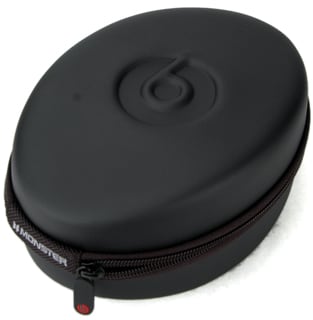
The beats also come with a fairly short cord, which is the perfect length for connecting to a pocketed media source. This being said, the Beats aren't nearly as portable as in-ear headphones because of sheer size. If you dont' like wearing in-ear headphones, the Beats would be a good, portable option.
The Beats don't come with many customization options in box, but then again, most headphones don't give you any options at all. First of all, the cups can tilt, which will help the Beats conform to a wide variety of heads. They can also collapse, which but not in a way that's particularly useful for DJs looking to mix with one ear since the open end of the cups always point inward. Compare the Beats' collapsibility to the Ultrasone HFI-2200s', which allow the cups to face outward.
The Beats do come with a spare cable that has a microphone on it for use with cell phones, iPhones, or anything else that can use a tiny mic. Now you can hook your company BlackBerry up to your Beats by Dr. Dre headphones for optimal professionalism.
Removing the cup padding on the Beats is a bit less straightforward than on most headphones. They don't just snap on and off; you kind of have to wiggle the pad around to get all the latches to unhook. Also, don't grip just the pad: it'll come off its panel really easily, and it's annoying to fit back on if it does.
Once you've gotten the padding and their panel off the Beats, you need a small Phillips-head screwdriver to remove the three outer screws. If you want to get at the driver itself, you can also unscrew the even tinier, inntermost circle of screws, although a typical screwdriver will be much too large for the job. Once the screws are out, the panel comes off and you can gaze upon the Beats' innards. We don't think you'll have much of a problem with dust getting in here, but it's nice for the mechanically inclined should something go wrong, or for modders with itchy soldering-iron fingers.
The internal organs of the Beats. Click for a detailed pic.
As a minor aside, the Beats also come with a cleaning tool: a soft cloth you can use to polish fingerprints off the headphones' glossy plastic.
This cloth will help you fight smudging on the Beats' glossy
black plastic.
Battery Dependency
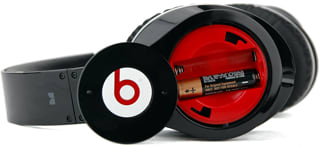
Sadly, the Beats live and die on their batteries. Without them you can't play back your music at all. This is typical for noise-cancelling headphones, but a few noise cancellers, like the Creative Aurvana X-Fis, will play back your music without batteries: you just will have to listen without the benefit of active noise cancellation. Also, and potentially more troubling, when the batteries get low, we noticed the playback randomly started to sound blown out. Keep your Beats' batteries charged; once that LED fades from red to yellow the Beats can get a little lax with how they handle sound.
*Noise Cancellation
*The Beats do have the enviable feature of noise cancellation, but unfortunately, it's not so much a bonus feature as it is a mandatory setting.
Mute Button
If you're too lazy to take off the Beats, and too distracted to flip the on/off switch, you can always employ the mute function. Pressing the 'b' above the on/off switch will temporarily mute playback.
Value & Comparisons

Value*(2.50)*
Like all noise-cancelling headphones, the Beats are overpriced. Add to this the double branding of Monster and Dr. Dre, and you just knew the Beats would cost more than they probably should. In this case, you're paying for aesthetic appeal and a detailed sound. These aren't headphones for music purists, who don't want their headphones fooling around with the playback, but purists generally know they won't get the quality they want from noise-cancelling headphones. The Beats seem especially overpriced when you consider how poor their active cancellation actually is. This being said, they are priced around what other noise-cancelling headphones are priced at. We do think that the Bose Headphones give you more for the price of purchase than the Beats do, but they also don't look as cool. While we certainly wouldn't recommend the Beats to a budget buyer or audiophile, if you're a mainstream listener looking for something flashy within the $300-400 range, we'd recommend at least giving the Beats a listen, if only to give yourself a better idea of what to look for in terms of sound and comfort.
Overall, however, if you're looking for portability, in-home use,isolation, or audio quality, there are better headphones available for cheaper.

[

Creative Aurvana X-Fi](https://www.reviewed.com/headphones/content/Creative-Aurvana-X-Fi-Headphones-Review-496.htm) - The X-Fi headphones are far more versatile than the Beats. They come with an extension cord to facilitate both portability and in-home use, have better isolation, and can opt to play back music without noise cancellation or batteries. The X-Fis also have the distinct advantage of costing $50 less and offering fun audio filters as well. The Beats do look a lot cooler, however, and have a much more solid frequency response. We tend to think the X-Fis are a better deal.
[

Sony MDR-NC500D](https://www.reviewed.com/headphones/content/Sony-MDR-NC500D-Headphones-Review-471.htm) - This match-up is the closest one for the Beats. The NC300D headphones also have poor overall audio quality, although they isolate and prevent leakage better than the Beats. They are about as comfortable and have similar durability issues. Like the Beats, they're battery dependent. They also let users select their own noise-cancellation curve, although this is more of a novelty than added functionality. The Beats, on the other hand, look better and are cheaper overall. We tend to think the Beats are a better deal, because they provide about the same quality (but better looks) for less money. Score one for the West Coast.
[

Bose QuietComfort 3](https://www.reviewed.com/headphones/content/Bost-QuietComfort3-Headphones-Review.htm) - The Bose QuietComfort 3 bests the Beats in terms of audio quality, but not by much. They have a far worse frequency response, but far less distortion. They also isolate better and leak slightly less. Since the QC3s are also the same price as the Beats, this one is a toss-up. We'd highly recommend listening to both before making your choice; this one really comes down to personal preference.
[

Sennheiser HD 555](https://www.reviewed.com/headphones/content/Sennheiser-HD-555-Headphones-Review.htm) - In your home, the HD 555s beat the Beats hands down. They have a longer cord, far better audio quality, and cost a lot less. In terms of portability, the Beats have the upper hand. The lack of isolation and leakage mean the outside world will often drown out your music. Also, the cord is a lot to lug around in your pocket. The Beats also have the option of connecting to your home theater setup assuming you can provide a long enough cable. Depending on how you plan on using your headphones, either pair could win this match-up.
[

Etymotic Research 6isolator](https://www.reviewed.com/headphones/content/Etymotic-6isolator-Headphones-Review.htm) - The 6isolators trounce the Beats soundly in terms of audio quality, sound isolation, and portability. They're also a lot cheaper. Though the Beats do have their merits, the 6isolator really do everything the Beats can do, but better. The only thing the Beats can offer that the 6isolators can't is a more open-sounding soundstage and music playback without having to stick something in your ear. For commuters, airplane travelers, or anyone else looking for good quality and portability, the 6isolators are a better choice.
Conclusion
Conclusion

The Beats are built for mainstream listeners. The detailing is great, and will, to many people, seem like absurdly high audio quality. Add in their comfortable design and interesting aesthetic, and the Beats are a solid option for this demographic.
That being said, the Beats have a few flaws that both limit their functionality and their audience. Although a minor issue, the Beats don't come equipped with a long cord. Most noise-cancellers try to play up their versatility, including a shorter cord to for daytime portability, and a lengthy extension cord for nighttime home stereo connectivity. The Beats were produced by Monster, who predominantly manufactures cables, so we were expecting a 16-foot long coil with gold-plated, 99% oxygen-free copper, and magical noise-reducing technology in-line. Alas, both cord options were short; if you pick up the Beats for your sound system at home, you'll need to pick up a longer audio cable as well.
The short cords indicate a focus on portability, but the Beats aren't necessarily the best choice for commuters. While they have active noise cancellation, it doesn't block out much more sound compared to other noise-cancellers or in-ear headphones. This will result in your morning train or bus drowning out your music more than it should. Of course, when you boost the volume to compensate for this lack of isolation, the poor leakage control will broadcast your music to those sitting around you.
Of course, there were also the issues with audio quality and the noise created by the active cancellation. To top it all off, you'll need to feed your Beats AAAs every so often to keep listening to music, which is a bit annoying considering how little the noise cancellation feature actually does.
All in all, we think the Beats are overpriced and under-perform, but that doesn't mean they aren't devoid of some solid attributes. We wouldn't necessarily recommend the Beats as a great buy, since they aren't for audiophiles by any stretch and they're priced too highly for most mainstream consumers. We do, however, see the Beats stealing away quite a few Bose adopters.

Probably not. Audiophiles might like the detailing, but the noise-cancellation's added noise will get on their nerves. Also, the distortion is a bit too much.
The Beats are probably best used as portable headphones. They're not a bad alternative for in-ear headphones, although they're lacking a bit in the isolation department. They're also versatile, because they can, given the right cord, also be used with a home theater setup.
We're not sure how to judge this one. There are better headphones for isolation, yes, but that doesn't mean the Beats would be abysmal on an airplane. The noise cancellation will help drown out the roar of the engines, and the battery life would probably last for an airplane ride around the world. If you're looking for a pair of headphones specifically for airplane travel, there are far better options than the Beats; if you're looking for headphones that do other things and are also an ok choice for an airplane ride, then the Beats meet that criteria.
This is another area we're reluctant to say yes or no to. No, they don't have a long cord, but if you have a longer audio cable you can hook it up to these. They also come with a 1/4-inch audio cable. Since they're over-ears, they'll provide a good sound-stage, although it won't sound as open as a dedicated pair of home-theater headphones. While the Beats can be squished into the role, if you're specifically looking for a set of home theater headphones, there are more appropriate headphones than the Beats.
Meet the tester
Mark Brezinski works on the Home Team, reviewing refrigerators, minifridges, dishwashers, washing machines, dryers, air conditioners, air purifiers, and fans.
Checking our work.
Our team is here to help you buy the best stuff and love what you own. Our writers, editors, and experts obsess over the products we cover to make sure you're confident and satisfied. Have a different opinion about something we recommend? Email us and we'll compare notes.
Shoot us an email